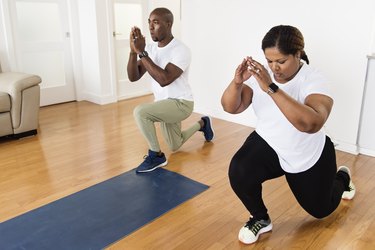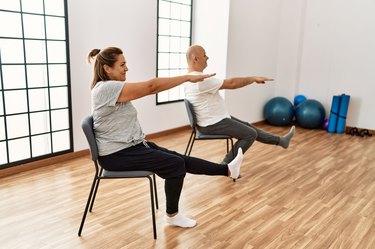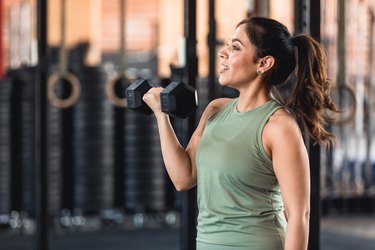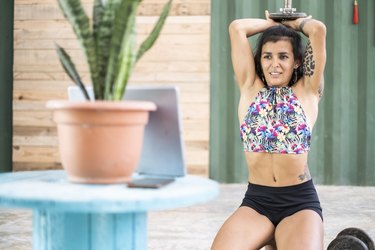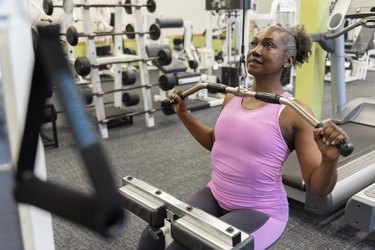
There are many potential exercises you could do when you hit the weight room. So many, in fact, that you might feel overwhelmed and not know where to start.
The good news is you can get great results using many different exercises. There are no "best" exercises that everyone needs to perform. However, you do need to pick exercises that match your skill level and goals to get the most out of your workouts.
Video of the Day
Video of the Day
Most people will get more out of their workouts if they focus on simple exercises they can perform well and improve on over time. "Don't get mired in the details or feel the need to get crazy fancy with things," Leann Hatler, CPT, tells LIVESTRONG.com.
Not everything you see on the internet will be appropriate for where you're at with your training. "Social media can be a great reference, but anyone can go about posting exercises or information without any context," Wesley Showalter, CSCS, tells LIVESTRONG.com "If you don't know any better, what you see on social media might seem applicable despite the fact that you have better options to fit your current training age and goals."
Use the six exercise selection principles below to help you make good decisions about which exercises to include in your workouts. Some of these principles apply to everyone, and others require you to consider your training age (how long you've been working out seriously), goals and injury history.
1. Train All Major Movement Patterns Each Week
Movement patterns are a way to categorize exercises based on how your body recruits different muscles and joints. N0 matter if you want to build strength, muscle or endurance, it's important to hit each major movement pattern at least twice per week.
Squatting, hinging, pushing and pulling are the four essential movement patterns. There are many possible exercises you could perform within each movement pattern. Here are a few examples:
- Squat: squat, split squat, lunge, step-up
- Hinge: deadlift, swing, good morning, hip thrust
- Push: push-up, bench press, overhead press
- Pull: chin-up/pull-up, lat pulldown, row
Need More Exercise Ideas?
- Examples of upper-body push exercises include the push-ups, bench presses and shoulder presses.
- Examples of upper-body pull exercises include rows, chin-ups and pull-downs.
- Examples of lower-body push exercises include squats, lunges, split squats and step-ups.
- Examples of lower-body pull exercises include deadlifts, Romanian deadlifts, kettlebell swings and leg curls.
- Examples of accessory or isolation exercises include biceps curls, lateral raises, triceps pushdowns, glute kickbacks and calf raises.
2. Prioritize Compound Exercises Over Isolation Exercises
Compound exercises use multiple joints and muscles, which means they can stimulate big changes within your body. Examples include squats, lunges, push-ups, rows and deadlifts. Isolation exercises, like biceps curls, triceps pressdowns, lateral raises and calf raises, target a single joint or muscle.
According to Showalter, people who train less frequently should focus primarily on compound movements, because they give you more bang for your buck. If you're training two or three times per week, the vast majority (if not the entirety) of your workouts should consist of compound exercises.
However, this doesn't mean there isn't a place for isolation training. Isolation exercises can bring up weak links or aid in efforts to build muscle when performed in conjunction with compound exercises. More advanced lifters can generally benefit more from isolation exercises than novice lifters.
Save isolation training for the end of your workouts. (Try a few sets of biceps and triceps exercises at the end of an upper-body workout.) Alternatively, if you train four or more times per week, you could have an entire day devoted to isolation training, so long as you perform enough compound exercises during your other workouts.
More on Compound Exercises
3. Pick Exercises That Feel Good on Your Joints and Allow You to Use a Full Range of Motion
One of the biggest mistakes people make at the gym is forcing their bodies to perform exercises that just aren't a good fit. This often happens because of preconceived notions about what we should be doing in the weight room.
Be honest with yourself about what does and doesn't work with your body. "Lots of people choose exercises they cannot execute with proper intent and fail to meet themselves where they are at from a movement capacity and capabilities standpoint," Showalter says.
It's liberating to realize that for the vast majority of fitness goals, you don't need to perform specific exercises. You can use different pieces of equipment, modify your body position or even make a lateral move within a movement pattern (like doing step-ups instead of squats) and still make progress.
If you experience joint pain during or after a workout, look for ways to modify or replace that particular exercise.
For best results, you should also pick exercises that allow you to use a full range of motion. Many times changing the way you hold the weight (i.e. switching from back squats to front squats) or using a different piece of equipment for the same exercise (i.e. switching from barbell squats to goblet squats) can dramatically improve your range of motion.
Joint-Friendly Exercises
4. Pick Exercises That Match Your Skill Levels
All exercises at the gym exist on a continuum of skill. Less technical exercises like glute bridges or TRX inverted rows require a relatively low degree of skill; more complex exercises like the clean and jerk and snatch require a significantly higher degree of skill. It takes time (often years of consistent training) to build the movement skills necessary to safely perform advanced exercises.
If you're just starting out, it's best to stick with easier exercises that you feel confident you can perform well. Focusing on gradually adding more volume and intensity to these movements will get you results without the need for gimmicks. Don't be in a rush to jump to the hardest possible exercises. And remember that just because something looks cool on social media doesn't mean it deserves a spot in your workouts.
Beginner Moves
5. Pick Exercises That Align With Your Goals
People come to the gym with different goals. Many want to get stronger or improve their endurance. Others are seeking hypertrophy, which means building bigger muscles. Still, others might be lifting weights to improve performance in a sport or active hobby.
If your main goal is to build strength, you need to choose exercises that allow you to lift heavy loads. You also don't need a ton of complexity or different exercises in your program. "You can make large gains in your strength with just a few basic lifts (like squats, deadlifts, presses and pulls) done well and consistently," Hatler says.
If your goal is endurance and you're doing longer sets, it doesn't make sense to program technically complex exercises. There are more moving pieces to monitor and you put yourself at risk of injury if your form starts to break down. Instead, pick less complex exercises that allow you to maintain good form even when you're fatigued.
Chasing hypertrophy allows for a greater range of potential exercises because you can train with a variety of rep ranges and intensities and still build muscle. Choose a mix of compound and isolation movements that follow the other criteria above. If you're struggling to get a muscle to grow, choose exercises where you can really feel the target muscle working.
More on Different Fitness Goals
6. Don't Put Too Many Exercises in One Workout
Picking exercises can be a lot of fun, but it's important not to get carried away. Performing too many exercises in one workout is a recipe for feeling extremely sore and missing subsequent workouts later in the week. Super long workouts are also impractical for busy people who don't have hours to devote to the gym.
"You don't need to crush yourself with a long workout that has 30 things in it," Hatler says. "Progress and big gains can happen in consistent 45 minute sessions with 10 exercises."
Most workouts should contain five to 10 main exercises, not including mobility fillers or warm-up drills. If you're struggling to fit in all the exercises you want to perform, consider adding an extra training day if possible.
